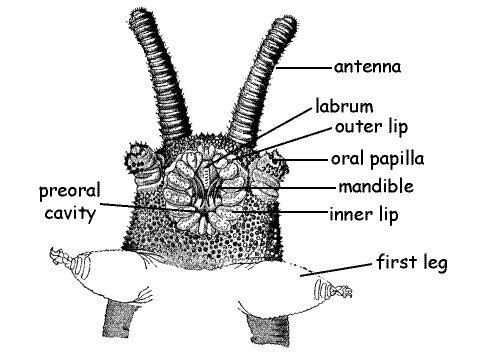
At the heart of what makes velvet worms so interesting are their slime glands and their claw-like legs. These features not only define their physical appearance but also play crucial roles in their survival and hunting strategies. So, grab your favorite coffee cup, and let’s dive into the wonderful world of velvet worm anatomy!
What Are Velvet Worms?
Velvet worms, or *Onychophora*, are soft-bodied, terrestrial invertebrates found primarily in tropical and subtropical regions. They have an intriguing appearance, resembling a cross between a caterpillar and a slug. Most species are relatively small, averaging around 2 to 10 centimeters in length.
These creatures thrive in damp environments, often hiding under leaf litter or in decaying wood. Their skin is covered in tiny, velvety hairs, which not only make them look cute but also help them sense their surroundings. Velvet worms are nocturnal, coming out at night to hunt for food. They primarily feed on small insects and other arthropods, using their specialized anatomy to catch and consume their prey.
Here’s a fun fact: velvet worms are considered “living fossils,” as they have changed very little over millions of years. Their unique features have stood the test of time, showcasing their adaptability and success as a species.
Understanding Slime Glands
One of the most fascinating aspects of velvet worm anatomy is their **slime glands**. These special glands are located along their bodies and are responsible for producing a sticky slime that plays several key roles in their lives. This is no ordinary goo; it’s specifically designed for hunting and defense!
When a velvet worm spots its prey (usually a small insect), it can squirt this slime at incredible speeds. The sticky substance entangles the unsuspecting creature, immobilizing it almost instantly. This hunting strategy is effective and allows velvet worms to catch food much larger than themselves. It’s like having a built-in spider web!
But the slime isn’t just for hunting. Velvet worms also use it as a defense mechanism. If threatened, they can release their slime to confuse or deter predators. Think of it as their personal shield, helping them escape danger. How cool is that?
The Structure of Slime Glands
So, how do these slime glands actually work? That’s where it gets really interesting! Each velvet worm has two pairs of slime glands situated near the head. These glands have a simple structure but pack a powerful punch.
The slime itself is made up of proteins and polysaccharides, which gives it that sticky consistency. When a velvet worm feels the need to use this slime, a series of contractions happen in the glands, forcing the slime out through openings near the mouth. This mechanism allows them to aim and shoot their slime effectively, much like a tiny superhero launching their webbing.
While the slime is primarily used for hunting, it should be noted that the composition can vary between species. Some may have stickier slime, while others have a more liquid form. This diversity helps them adapt to different environments and prey types.
Claw-Like Legs: A Closer Look
Now, let’s talk about those **claw-like legs**. Velvet worms have a unique leg structure, with up to 40 pairs of legs. Each leg is equipped with tiny claws that help them grip surfaces as they crawl through their habitat. This design is crucial for their movement and hunting strategies.
Their legs function a bit like a combination of insect legs and tiny suction cups, allowing them to traverse various terrains without slipping. This is especially important in their moist environment, where a good grip can make the difference between finding a meal or going hungry.
Interestingly, these legs are not just for movement. When a velvet worm catches its prey, it uses its legs to hold onto the struggling victim while it delivers its deadly slime. This combination of slime and claws makes them effective predators. You might think of them as nature’s little ninjas, stealthily capturing their food.
Why Velvet Worm Anatomy Matters
Understanding the anatomy of velvet worms can shed light on broader ecological concepts. Their unique adaptations have allowed them to thrive for millions of years, showcasing the importance of evolutionary traits in survival. This is critical to understand if we want to appreciate biodiversity and the intricacies of life on Earth.
Moreover, studying these organisms can also have implications for biotechnology. For example, researchers are looking into the properties of their slime to develop new materials or adhesives. The advancements in materials science could be influenced by understanding how velvet worms produce and utilize their slime.
By looking closely at velvet worms, we can draw connections to other species and ecosystems, highlighting the intricate web of life that surrounds us. Each creature plays a vital role, and learning about them helps us appreciate the delicate balance of nature.
Velvet worms, with their **slime glands** and **claw-like legs**, offer a glimpse into the complexity of evolutionary adaptations. They remind us that even the smallest creatures can have incredible stories and functions that are essential to their survival. Whether it’s their unique hunting methods or their impressive anatomy, velvet worms are truly extraordinary.
As you think about these remarkable creatures, consider how they fit into the bigger picture of our planet’s biodiversity. Their unique features not only help them survive but also inspire us to delve deeper into the wonders of the animal kingdom. Next time you hear “velvet worm,” you can impress your friends with your newfound knowledge of their anatomy and role in nature!
